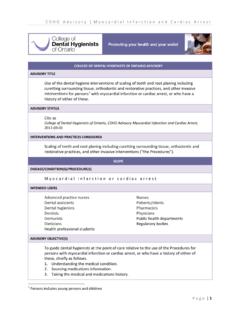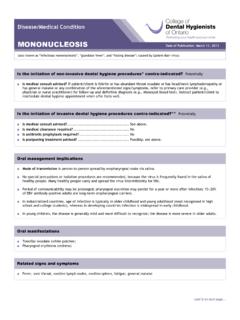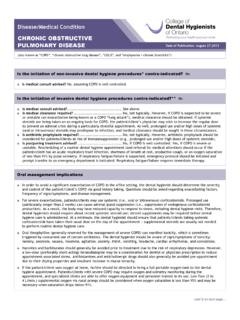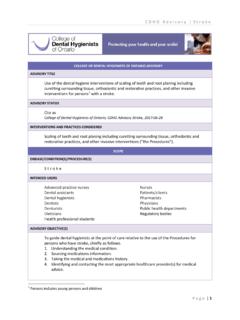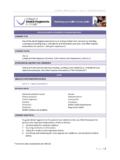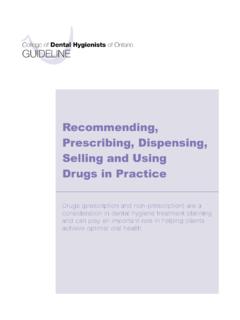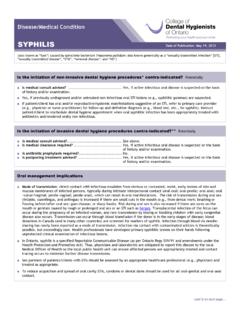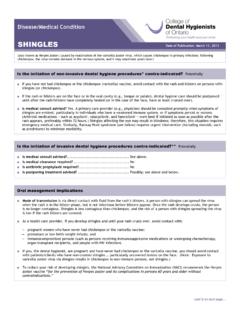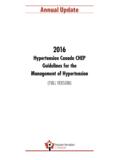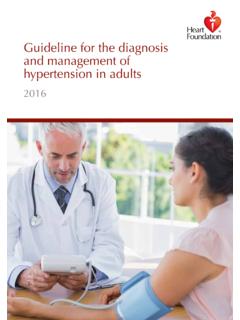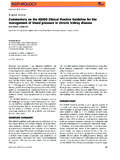Transcription of CDHO Advisory Hypertension
1 cdho Advisory | Hypertension COLLEGE OF DENTAL HYGIENISTS OF ONTARIO Advisory . Advisory TITLE. Use of the dental hygiene interventions of scaling of teeth and root planing including curetting surrounding tissue, orthodontic and restorative practices, and other invasive interventions for persons 1 with Hypertension . Advisory STATUS. Cite as College of Dental Hygienists of Ontario, cdho Advisory Hypertension , 2017-07-18. INTERVENTIONS AND PRACTICES CONSIDERED. Scaling of teeth and root planing including curetting surrounding tissue, orthodontic and restorative practices, and other invasive interventions ( the Procedures ). SCOPE. DISEASE/CONDITION(S)/PROCEDURE(S). Hypertension INTENDED USERS. Advanced practice nurses Nurses Dental assistants Patients/clients Dental hygienists Pharmacists Dentists Physicians Denturists Public health departments Dieticians Regulatory bodies Health professional students Advisory OBJECTIVE(S).
2 To guide dental hygienists at the point of care relative to the use of the Procedures for persons who have Hypertension , chiefly as follows. 1. Understanding the medical condition. 2. Sourcing medications information. 3. Taking the medical and medications history. 4. Identifying and contacting the most appropriate healthcare provider(s) for medical advice. 1. Persons includes young persons and children Page |1. cdho Advisory | Hypertension 5. Understanding and taking appropriate precautions prior to and during the Procedures proposed. 6. Deciding when and when not to proceed with the Procedures proposed. 7. Dealing with adverse events arising during the Procedures. 8. Keeping records. 9. Advising the patient/client. TARGET POPULATION.
3 Child (2 to 12 years). Adolescent (13 to 18 years). Adult (19 to 44 years). Middle Age (45 to 64 years). Aged (65 to 79 years). Aged 80 and over Male Female Parents, guardians, and family caregivers of children, young persons and adults with Hypertension . MAJOR OUTCOMES CONSIDERED. For persons who have Hypertension : to maximize health benefits and minimize adverse effects by promoting the performance of the Procedures at the right time with the appropriate precautions, and by discouraging the performance of the Procedures at the wrong time or in the absence of appropriate precautions. RECOMMENDATIONS. UNDERSTANDING THE MEDICAL CONDITION. Terminology used in this Advisory Resources consulted High blood pressure , hypertensive crisis ( Hypertension ): Mayo Clinic Hypertension : Hypertension Canada Hypertension : MedlinePlus Hypertension : PubMed Health Hypertension 1.
4 Refers to blood pressure that persistently exceeds specified limits 2. is sometimes classified by a. the absence or presence of identifiable cause, as in i. essential Hypertension , lacks identifiable cause, represents 90 percent of diagnoses of Hypertension ii. secondary Hypertension , linked to one or more identifiable causes, such as medical conditions or medications, including 1. aldosteronism ( cdho Advisory ) in which an adrenal gland tumour causes excessive release of the hormone aldosterone, which raises blood pressure because the kidneys Page |2. cdho Advisory | Hypertension a. retain salt and water b. lose too much potassium 2. coarctation of the aorta, congenital narrowing of the aorta, which causes the heart to pump with increased force, which a.
5 Is necessary to get blood through the aorta b. raises the blood pressure 3. Cushing's syndrome ( cdho Advisory ) in which a pituitary tumour or other abnormalities cause the adrenal glands to produce too much cortisol, which increases the blood pressure 4. diabetes ( cdho Advisory ) complications of which cause kidney damage leading to high blood pressure 5. glomerular disease, a type of kidney disease ( cdho Advisory ) in which problems with the kidney's filters lead to high blood pressure 6. hyperparathyroidism, excessive secretion of parathyroid hormone which increases blood calcium and leads to increased blood pressure 7. hyperthyroidism ( cdho Advisory ), excessive secretion of thyroid hormone leading to high blood pressure 8.
6 Hypothyroidism ( cdho Advisory ), insufficient secretion of thyroid hormone leading to high blood pressure 9. medications, supplements may raise blood pressure 10. substances of abuse ( cdho Advisory ) may increase blood pressure 11. obesity ( cdho Advisory ) raises blood pressure by a. putting pressure on artery walls b. increasing heart rate 12. pheochromocytoma, rare adrenal gland tumour, increases production of adrenaline and noradrenaline, which raises blood pressure 13. polycystic kidney disease ( cdho Advisory ), in which kidney cysts impair kidney function and may lead to raised blood pressure 14. pregnancy ( cdho Advisory ) may a. exacerbate existing high blood pressure b. cause high blood pressure leading to a potentially dangerous condition, preeclampsia, also termed pregnancy-induced Hypertension 15.
7 Renovascular Hypertension 16. sleep apnea ( cdho Advisory ), often marked by severe snoring, in which breathing repeatedly stops and starts during sleep, causing oxygen deprivation which, through a sequence of effects, increases blood pressure b. specific parts of the vascular system in which it occurs, such as i. portal Hypertension , in which impairment of blood flow in the liver causes varicosities of the portal vein; commonly associated with cirrhosis of the liver ii. pulmonary Hypertension , a rare disorder of the blood vessels of the lung in which the pressure in the pulmonary artery increases even to the point Page |3. cdho Advisory | Hypertension of becoming life-threatening; sometimes the cause is identifiable, sometimes not iii.
8 Renovascular Hypertension , narrowing of the arteries that carry blood to the kidneys, most commonly associated with atherosclerosis of these arteries c. severity, medical condition or health status, such as i. malignant Hypertension , very high blood pressure which 1. develops suddenly 2. is a severe and dangerous form of high blood pressure 3. is associated with papilledema 4. is an emergency condition which can be life-threatening ii. vascular disorders, such as heart disease, which may be consequences as well as causes of Hypertension iii. kidney disorders, may be consequences as well as causes of Hypertension iv. preeclampsia, Hypertension and proteinuria that develops after week 20. of pregnancy v. endocrine Hypertension , overproduction of aldosterone by the adrenal gland caused by malfunction or tumour, which leads to fluid retention and increased blood pressure .
9 Other terminology 1. Abdominal aortic aneurysm, when the aorta becomes abnormally large or balloons outward, creating the risk of rupture, a major medical emergency. 2. Atherosclerosis, disease of large and medium-sized arteries in muscles, which a. is characterized by hardening and narrowing of the arteries caused by the accumulation of fatty deposits called plaque b. may cause a blood clot to form at the site of the narrowing, which completely i. blocks the artery ii. and, in a coronary artery, causes myocardial infarction ( cdho Advisory ). 3. Body Mass Index (BMI) body weight in kg divided by height in meters squared (kg/m2). 4. Cardiac dysrhythmia, cardiac arrhythmia, irregular or abnormal heart rate. 5. Dyspnea, shortness of breath, breathlessness.
10 6. Hypertensive crisis, a severe increase in blood pressure that creates a. urgency, where blood pressures is dangerously high but has not apparently caused damage to any organ b. emergency, where blood pressure is dangerously high and i. has caused damage to an organ ii. may be associated with life-threatening complications, such as a stroke. 7. Hypertensive retinopathy, damage to the blood vessels in the retina caused by high blood pressure , which may result in serious effects on vision. 8. Lichen planus, an itchy rash affecting the skin or mouth. 9. Papilledema, swelling of the optic nerve behind the eye. 10. Peripheral arterial disease, narrowing and hardening of the arteries that supply the legs and feet, caused by arteriosclerosis.

